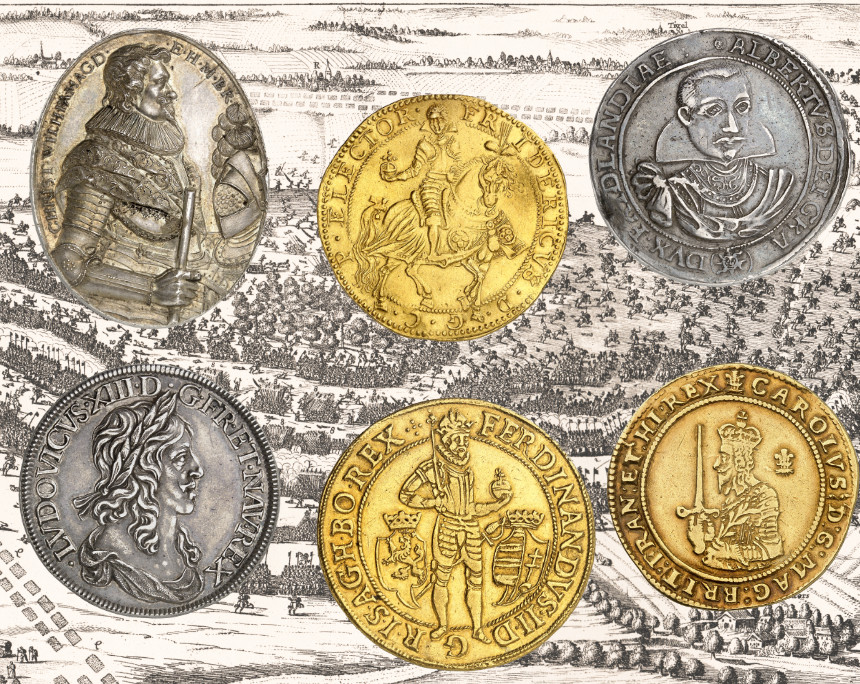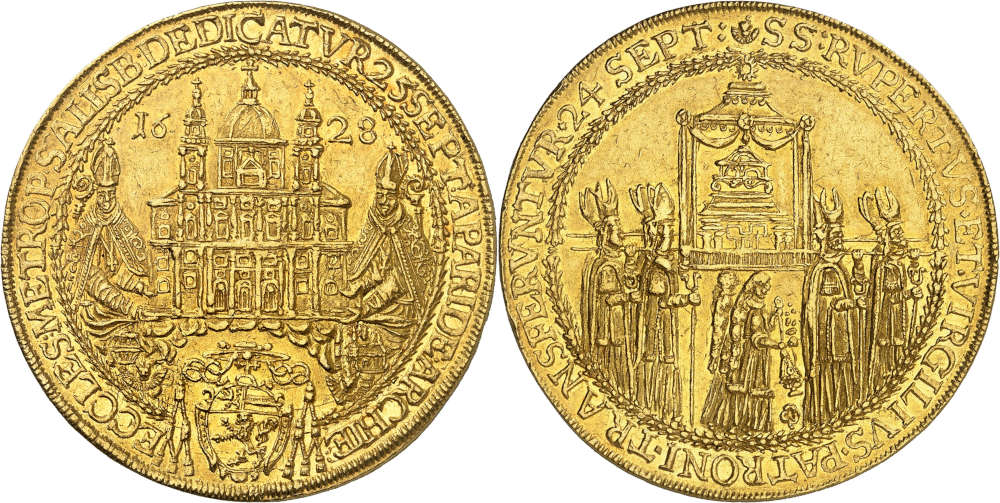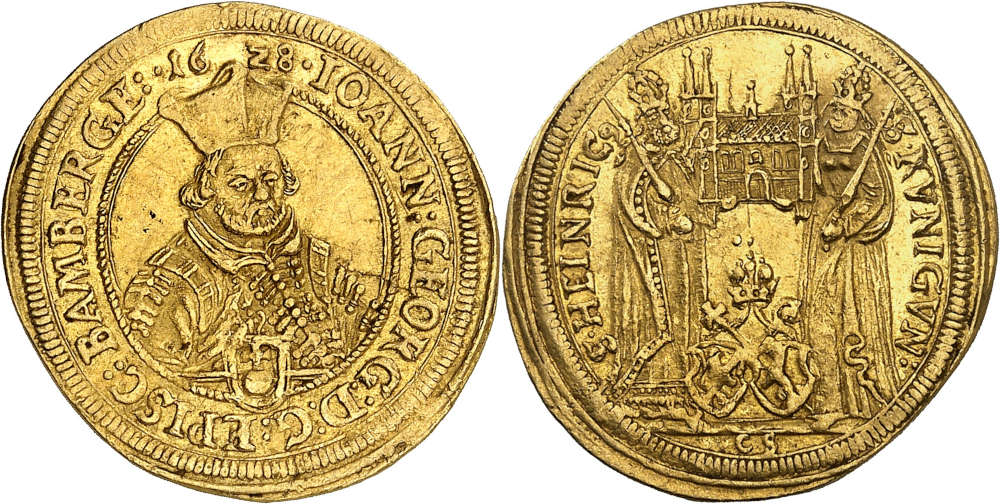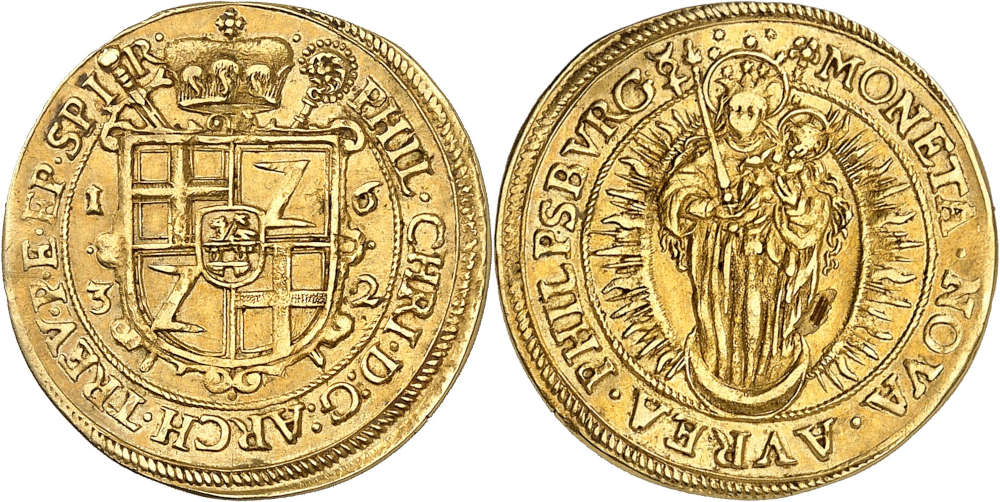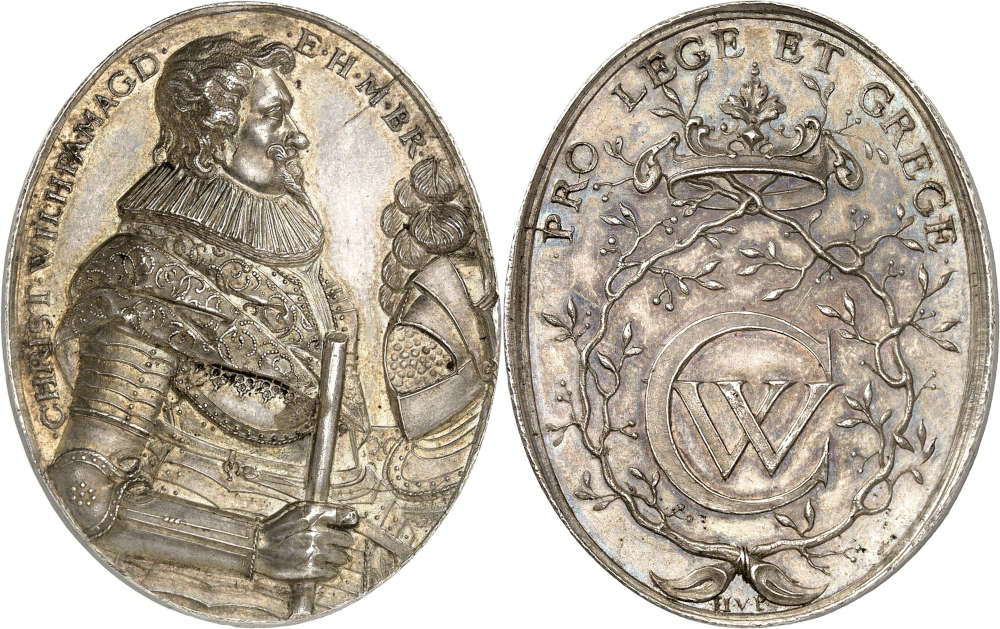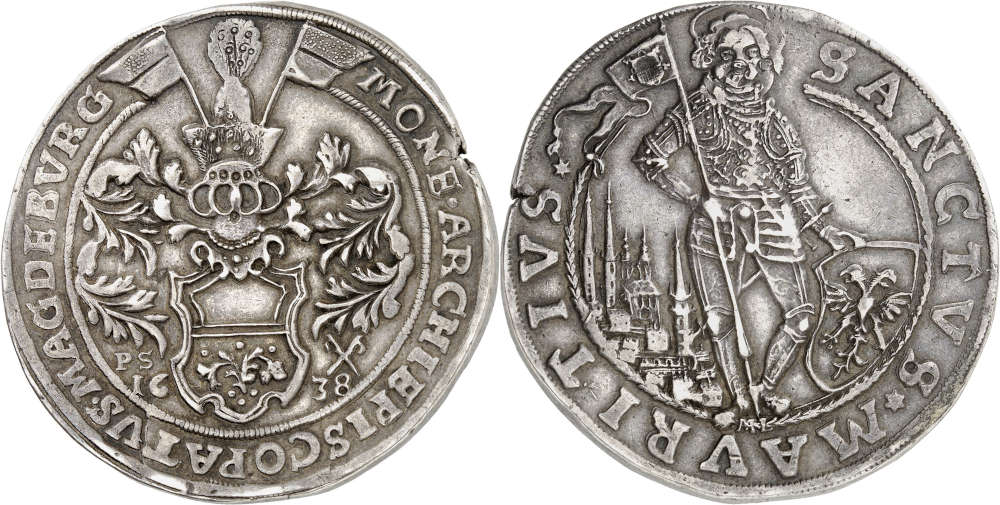The Protagonists of the Thirty Years’ War: A Slightly Different Preview of Künker’s Auction 410
On 23 September 2024 Künker will auction off a breathtaking collection including many multiple gold coins, multiple talers and rare medals relating to the Thirty Years’ War. We present the most beautiful pieces, and explain why the men depicted on these issues took part in the Thirty Years’ War.
Content
Do you really think that the Thirty Years’ War was about religion? Well, there were devout people at the time – but very few of them went to war for that reason. Most of them had other motives, and these might well be summed up as land, power and money.
In this somewhat different preview, we will introduce the most important protagonists of the Thirty Years’ War on coins, and explain why they took part in this conflict. You can look forward to stunning pieces from the collection of a German manufacturer and history enthusiast.
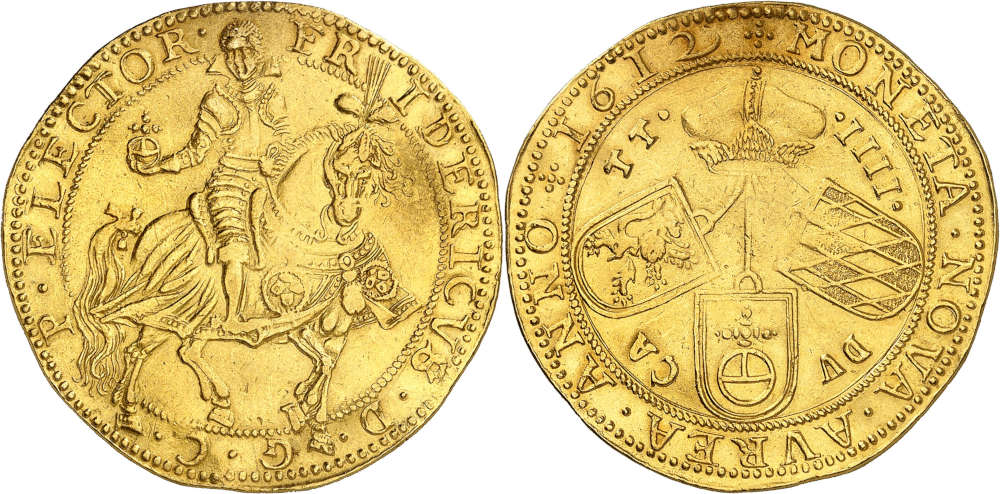
Frederick of the Palatinate. 4 ducats, 1612. Very rare. Minimally worked at the edge. Very fine to extremely fine. Estimate: 15,000 euros. Künker 410 (23 Sept. 2024), No. 111.
The Winter King
Lead us start with ambitious Count Palatine Frederick V, whose accession to the throne prompted the Thirty Years’ War. The rebellious Bohemian estates brought him to Bohemia to replace the Habsburg Archduke Ferdinand. Frederick saw a golden opportunity to elevate himself and, perhaps, become the next emperor. After all, the emperor was elected by the seven electors. Three of them – the archbishops of Cologne, Mainz and Trier – traditionally voted for a Catholic candidate; the other three – Saxony, Brandenburg and the Rhine Palatinate – were under Protestant control. This 1612 quadruple ducat by Frederick V shows how much prestige was attached to the title of an elector: he prominently featured his title ELECTOR in the legend.
The decisive vote in the electoral college was cast by the King of Bohemia, who had been a Habsburg so far. If Frederick was to replace the Habsburgs, the scales would tip. This would pave the way for a Protestant emperor.
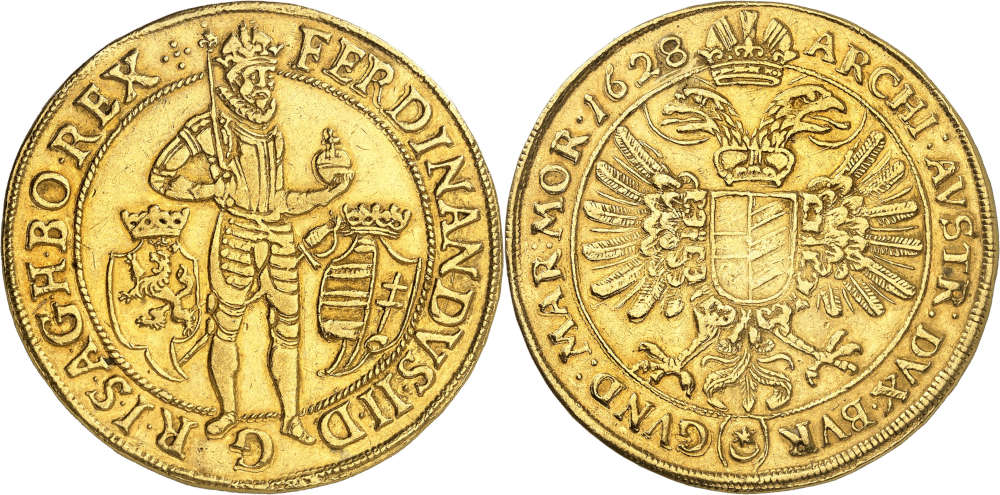
Ferdinand II. 10 ducats, 1628, Prague. Very rare. Very fine. Estimate: 25,000 euros. Künker 410 (23 Sept. 2024), No. 106.
The Emperor
This is the reason why the Habsburgs fought for Bohemia, even though Ferdinand II had been unanimously elected emperor on 28 August 1619. This coin from the year 1628 presents him in all his glory: with crown, scepter, orb and cross as well as the crowned escutcheons of his two kingdoms of Bohemia (left) and Hungary (right).
However, there was even more at stake for the Emperor: this conflict was also about maintaining his influence as the empire’s supreme ruler in the face of princes who were becoming increasingly independent. In short, this was a fight with the central state on one hand and small territorial dominions on the other.
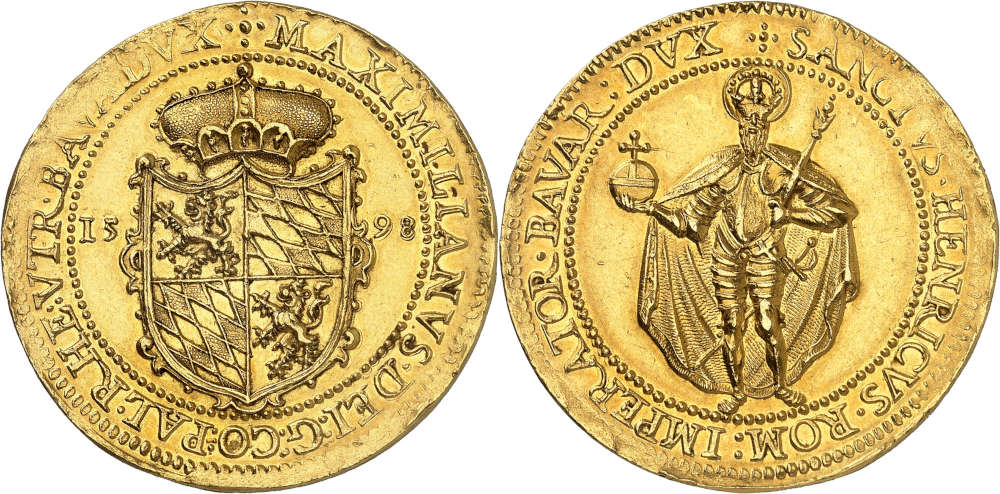
Maximilian I. 8 ducats, 1598, commemorating the estates doing homage to him. Very rare. Extremely fine. Estimate: 30,000 euros. Künker 410 (23 Sept. 2024), No. 156.
The Duke of Bavaria
The most important ally of the Habsburg dynasty was Duke Maximilian I of Bavaria. This coin bears witness to the fact that there was certainly no absolutist rule BEFORE the Thirty Years’ War. After all, the 8-fold ducat was issued in 1598 to commemorate the Bavarian estates doing homage to Maximilian. At the time, any ruler had to get the approval – the homage – of the estates to be able to take office. The ceremony was preceded by lively debates, in which the new duke had to make major or minor concessions depending on the political situation. Maximilian I had went through this process. He had to make painful concessions so that the estates would help pay off his father’s immense debts.
Maximilian used the war to enforce absolute supremacy in his own duchy. He seized control of the estates, local nobility and church property. At the same time, he took advantage of the miscalculation of the Winter King, who was also from the House of Wittelsbach: Maximilian demanded Frederick’s electoral vote in return for his support of the emperor. He was to receive it, along with the Upper Palatinate.
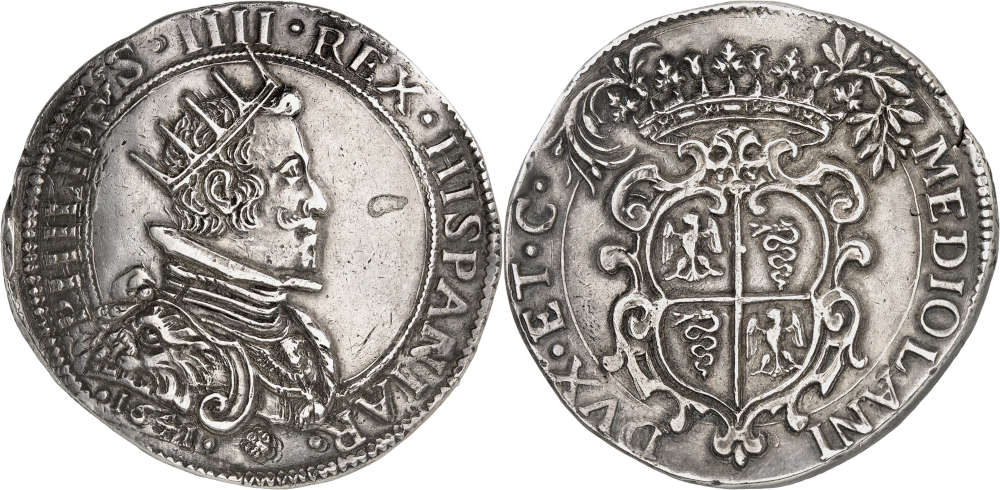
Milan / Italy. Philip IV. 2 ducatoni, 1641. Very rare. Very fine to extremely fine. Estimate: 15,000 euros. Künker 410 (23 Sept. 2024), No. 30.
The Spanish Habsburgs
Family ties were certainly not the reason why the Spanish Habsburgs became allies of the Emperor. They used the empire as a theatre of operations against the Netherlands. After all, the supplies for the army fighting there came from their rich possessions in northern Italy. This magnificent double ducatone comes from Milan, which had been ruled by the Spanish Habsburgs since 1525. The easiest route from there to the Dutch theatre of war was over the Alpine passes of Grisons to Lake Constance, and from there by ship up the Rhine towards the North Sea. The Protestant princes who controlled part of the Rhine interfered with Spanish logistics. The Spanish war aim was therefore to secure the Rhine for their Catholic allies to control their supply routes. This plan became obsolete with the Peace of Westphalia, as the battle for the Netherlands ended with the country’s independence.
The Catholic Empire
We mentioned land, power and money as the most important reasons for princes to go to war. Church property – abbeys, monasteries and bishoprics – were exactly that: land, power and money. The Catholic nobility had provided their descendants with ecclesiastical positions for centuries. So their motivation to fight in the war was to keep the rich abbeys and bishoprics under Catholic control. They demanded that the Protestants return the church property they had illegally confiscated. The Catholics based their claim on the Peace of Augsburg. In this treaty, the Protestants had signed a clause stating that ecclesiastical princes had to return not only their ecclesiastical but also their temporal rule if they changed their religion.
The Protestant Empire
Of course, the Protestant administrators were not willing to do that. Who would voluntarily give up land, power and money? Since 1555, many rich abbeys, monasteries and bishoprics had come under Protestant control. We will only mention Bremen and Magdeburg at this point. We must keep in mind that this was not just about the administrators at the very top. There were many more or less well-paid positions associated to every institution, from the cathedral chapter to the sexton. And, of course, in many cases the sovereign decided to secularize the entire estate in order to salvage his finances. The return of all church property would have effectively resulted in the financial ruin of the Protestant princes.
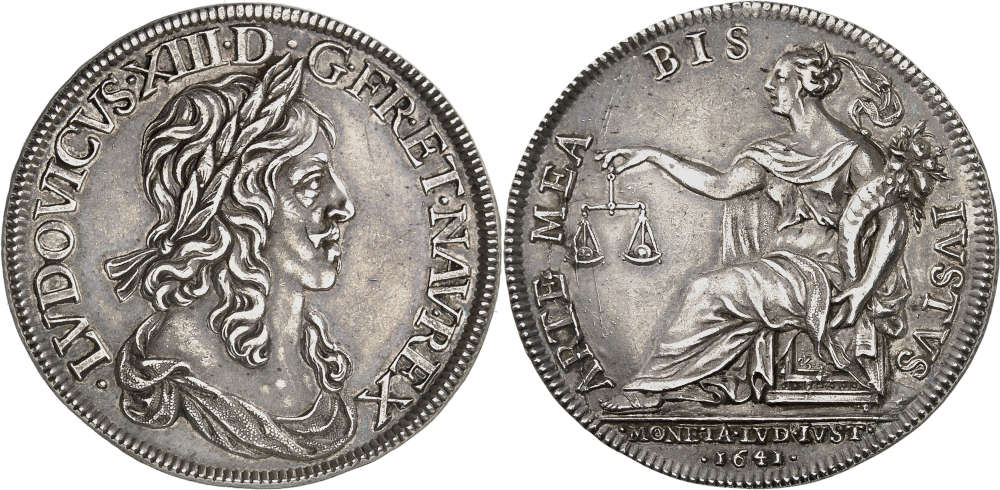
France. Louis XIII. Silver pattern for the 1641 louis d’argent (60 sols). Very rare. Extremely fine. Estimate: 15,000 euros. Künker 410 (23 Sept. 2024), No. 18.
The Enemy of My Enemy Is My Friend – France
There was probably no one who gave as much financial support to the enemies of the Habsburgs as France. And that should not be a surprise. The Habsburgs were perceived as France’s arch-enemies who threatened to encircle the whole country. They ruled beyond the Pyrenees, across the Rhine, in the north over Flanders and had thwarted the fine plans of Francis I in Italy. Cardinal Richelieu and his successor Mazarin – who had taken over the role as foreign policy-makers from the French kings – therefore systematically supported the Protestant Union. Their pragmatic strategy turned out to be a success: after the Thirty Years’ War, France replaced Habsburg Spain as the leading power in Europe.
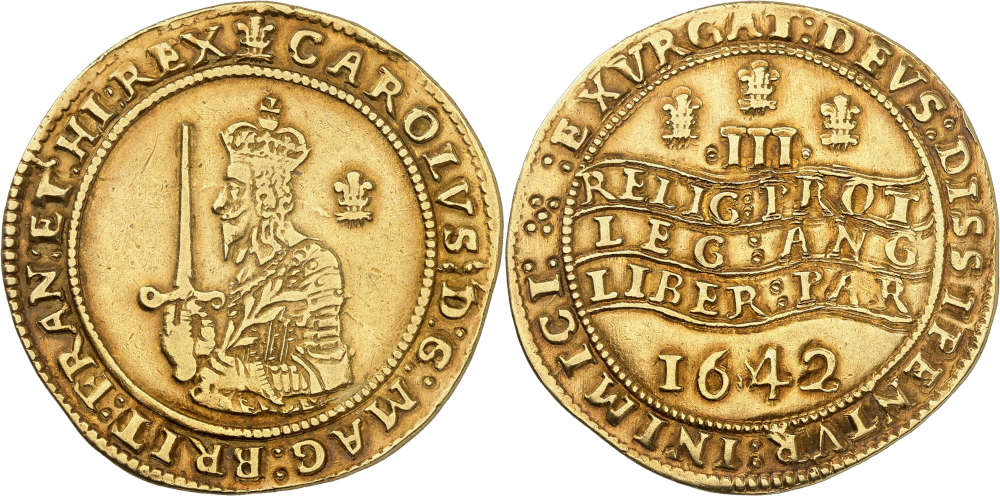
England. Charles I. 1642 triple unite, Oxford. Very rare. About extremely fine. Estimate: 40,000 euros. Künker 410 (23 Sept. 2024), No. 15.
The Enemy of My Enemy Is My Friend – England
Charles I would have liked to do something similar. The Habsburgs were the fiercest competitors of his expanding commercial empire. In addition, the Winter King was his son-in-law. If the Holy Roman Empire had come under his family’s control, this would have meant a significant increase in power!
Unfortunately, Charles I had much less money than the French king. His predecessor had left him with huge debts. Charles I tried to reorganize his state budget by dipping into the wealth of the bourgeoisie, but the estates did not approve at all. He had no choice but to make peace with France and Spain, abandoning his son-in-law. England thus withdrew from them Thirty Years’ War. This did not help Charles I. The dispute over money culminated in the English Civil War, and this coin is from the first year of this very conflict. Ultimately, Charles’ reckless spending cost him his head when he was beheaded on 30 January 1649.
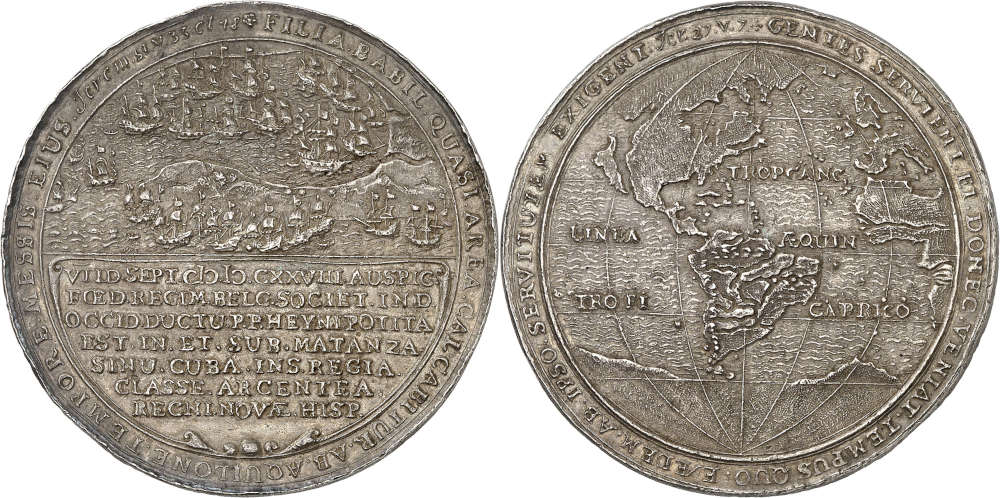
Netherlands. 1628 silver medal, commemorating Piet Heyn’s attack of the Spanish treasure fleet in the Bay of Matanzas. Extremely rare. Extremely fine. Estimate: 10,000 euros. From auction 410 (23 September 2024), No. 95.
The Enemy of My Enemy Is My Friend – the Netherlands
Needless to say, the Netherlands supported anything that would prevent the Spanish Habsburgs from sending troops against their own army. Once again, this player was also less concerned with religion and freedom than with land, power and money. The latter was particularly important to the Netherlands: After all, it was an emerging trading nation, whose ships carried spices, slaves and exotic luxury goods, making enormous profits.
The Spanish Habsburgs were its rivals. And the Netherlands wanted to hurt its rivals. For this purpose, the Dutch turned to privateering. They issued letters of marque that “commissioned” private individuals to attack enemy ships. When the Dutch West India Company attacked the Spanish treasure fleet in 1628, it was considered a great success. This success is depicted on this medal. During the attack, treasure worth 12 million guldens was seized and later distributed among the shareholders. Those who had invested in the Dutch West India Company received 50% of their investment as a dividend that year. The United Provinces, who were also shareholders, used the profits to finance the taking of Hertogenbosch.
Despite all the treasure from the New World, the Dutch financial policy was superior to Spanish strategies. This meant that there was more money for the army. And therefore, the Netherlands was also among the winners of the Thirty Years’ War. As a result, Spain had to recognize its independence.

Denmark. Christian IV. 1611 gold gulden, Copenhagen. Very rare. Very fine to extremely fine. Estimate: 10,000 euros. From auction 410 (23 September 2024), No. 9.
Those Who Jumped on the Bandwagon – Denmark
Whenever a war causes chaos and turmoil, there is always a chance of winning land, power and money. That is also was Danish King Christian IV thought when he had himself be elected Circle Colonel of the Lower Saxon Circle. As a champion of Protestantism, he hoped to reap rich rewards for Denmark. However, he did not manage to raise enough money to pay for his army. This resulted in a crushing defeat. His only luck was that there was already someone waiting in the wings, eager to take his place. That is why the supporters of the Emperor granted him favorable peace terms. Christian withdrew from the Thirty Years’ War in 1629, having neither won nor lost anything.
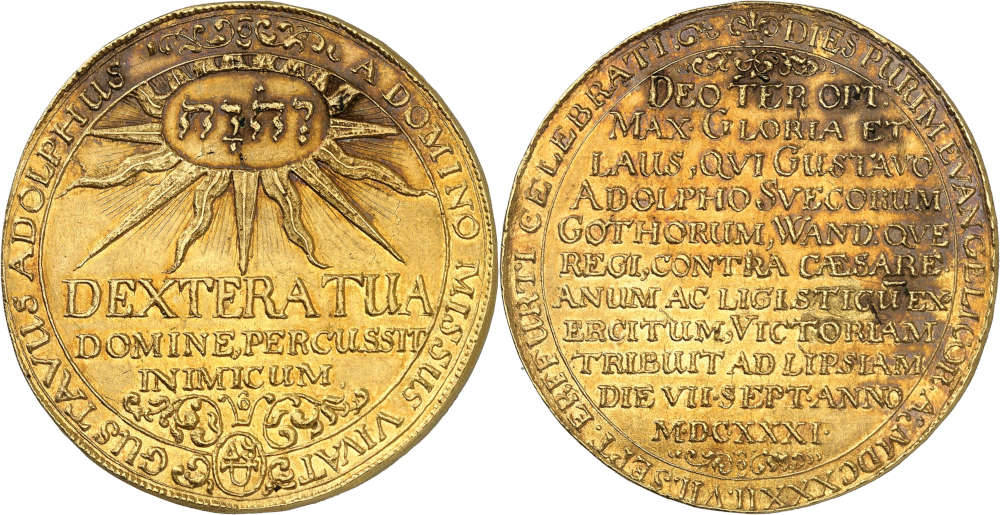
Sweden. Gustav II Adolf. 10 ducats, 1632, commemorating the anniversary of the Swedish victory at Breitenfeld. Extremely rare. Extremely fine. Estimate: 40,000 euros. From auction 410 (23 September 2024), No. 228.
Those Who Jumped on the Bandwagon – Sweden
Things turned out completely different for his successor Gustav II Adolf, King of Sweden. He stylized himself as the protagonist of Protestantism, although – once he was finished with them – most Protestants would have preferred if he had never intervened on their behalf. After all, the Swedish army did not live from French subsidies but from the land they passed through. Everyone, whether defeated enemy or honored ally, had to sacrifice their wealth to finance Gustav Adolf’s triumph.
In contrast to his army, the Swedish king still enjoys a good reputation today. This is due to his truly excellent propaganda strategies, which included minting coins such as this one.
It is an off-metal strike in gold of 10 ducats minted from the dies of the Purim taler. Gustav Adolf invoked a story from the Old Testament: By celebrating Purim, the Jewish people commemorated the fact that they had been saved from annihilation. In the same way – according to the message of the coin – Gustav Adolf’s victory at Breitenfeld prevented the annihilation of the Protestants. This is utter nonsense. Gustav Adolf had only prevented Protestant princes from having to return the territories that they had confiscated in violation of the terms of the 1555 Peace of Augsburg.
Even though Gustav Adolf paid with his life for his commitment, the Swedes were among the great winners of the Thirty Years’ War. They got what everyone wanted: land, power and money. By the end of the war, they were the dominant power in northern Europe.
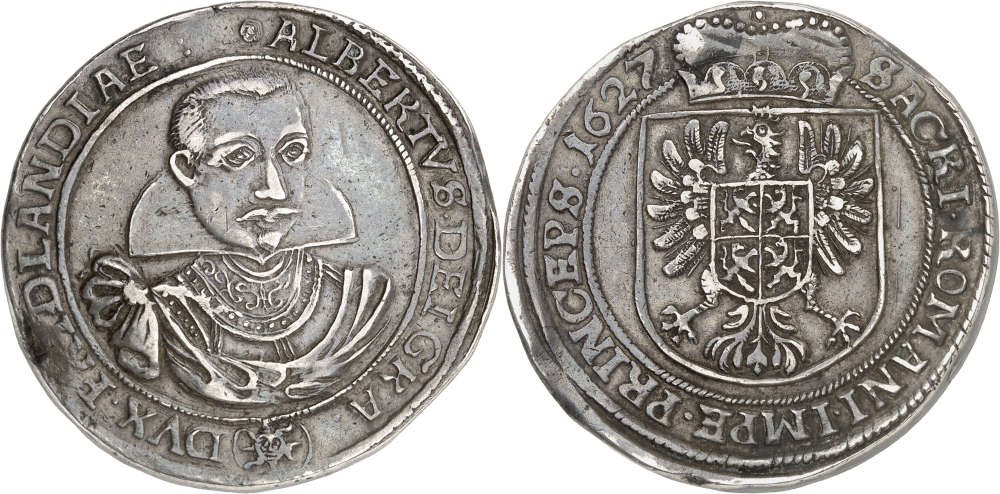
Wallenstein. 1627 double reichstaler, Jitschin. Very rare. Very fine. Estimate: 50,000 euros. From auction 410 (23 September 2024), No. 425.
Those Who Jumped on the Bandwagon – Wallenstein
It was not only states and kings who tried to gain land, power and money by intervening in the Thirty Years’ War. Private entrepreneurs and military leaders also took advantage of the situation. The entrepreneur Albrecht von Wallenstein is probably the best-known winner of the war, and his comet-like rise was just as fascinating as his sudden death.
Albrecht von Wallenstein’s way of thinking seemed to be much too modern for his age. First, he made a fortune as part of a group that contributed to the debasement of coinage during the financial crisis called “Kipper und Wipper”; then he acquired large estates for little money that the emperor had seized from his political enemies. He organized these estates in an extremely efficient way, enabling him to finance a major army with the surplus. This army could have made him the most influential man in Europe had he not been assassinated. Nobody attempted to continue his efforts. The Emperor confiscated his property and left only a few small parts of his fortune to his heirs.
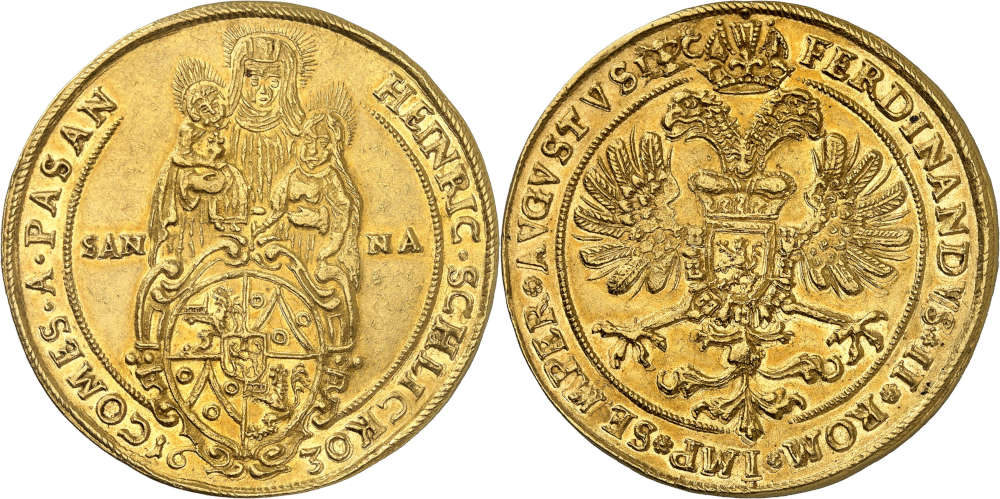
Schlick. Heinrich Schlick zu Bassano und Weißkirchen. 10 ducats, 1630. Mining issue. Unique. Extremely fine. Estimate: 100,000 euros. From auction 410 (23 September 2024), No. 142.
Those Who Jumped on the Bandwagon – Heinrich Schlick
The case of Heinrich Schlick zu Bassano und Weißkirchen was quite different. He made a career working for the emperor. He was considered a trustworthy military commander, which is why Ferdinand II gave him a large part of the possessions he had taken from the Protestant branch of the Counts of Schlick. This branch had supported the Winter King during the Bohemian Revolt. Heinrich von Schlick converted to Catholicism in 1622 and became president of the imperial war council in 1632. He therefore had a decisive impact on the outcome of the Thirty Years’ War. He left his fortune and his influence to his descendants, who were to become one of the leading dynasties in Bohemia.
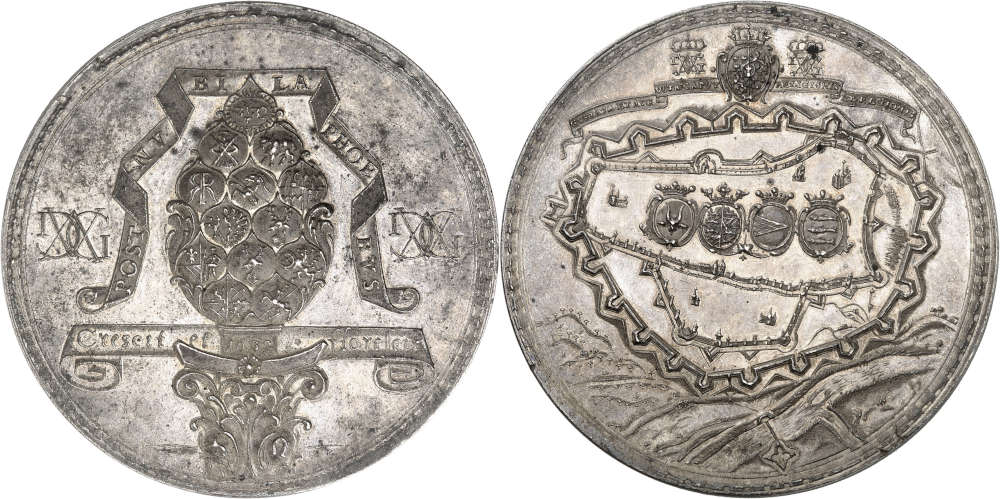
Augsburg. Silver medallion of 4 talers, 1632, commemorating the city being handed over to Swedish King Gustav Adolf. Very rare. Extremely fine +. Estimate: 10,000 euros. From auction 410 (23 September 2024), No. 149.
The Losers
After so many winners, we will now turn our attention to the losers – and there were many more of them, although they did not make it onto coins. The losers of the war were all those who had earned their living in an honest way: citizens, farmers, craftsmen and merchants. A terribly large number of them were looted, robbed, tortured and murdered. Their daughters and wives suffered brutal rape, starvation and disease. If you want to get an idea, read The Adventures of Simplicius Simplicissimus. But be careful! You will need strong nerves if you have a vivid imagination. Let us just say that the war claimed between 3.5 and 6.5 million civilian lives.
Besides unprotected farms, it was the once-rich trading towns that suffered the most. Take Augsburg as an example. Before the Thirty Years’ War, the city had been one of the richest trading centers in Europe. After the Thirty Years’ War, it was ruined. More than half of its households no longer existed. Augsburg never recovered. To this day, it is overshadowed by the Bavarian residence in Munich.
These were just some of many spectacular coins and medals in Künker’s auction 410. Do not miss out on carefully studying the catalog! And for all those who want to get their hands on a future standard reference on coins and medals of the Thirty Years’ War: contact Künker’s customer service at Nobbenburger Straße 4a, 49076 Osnabrück, Germany; phone: +49 541 / 962020; fax: +49 541 / 9620222; or via e-mail.








